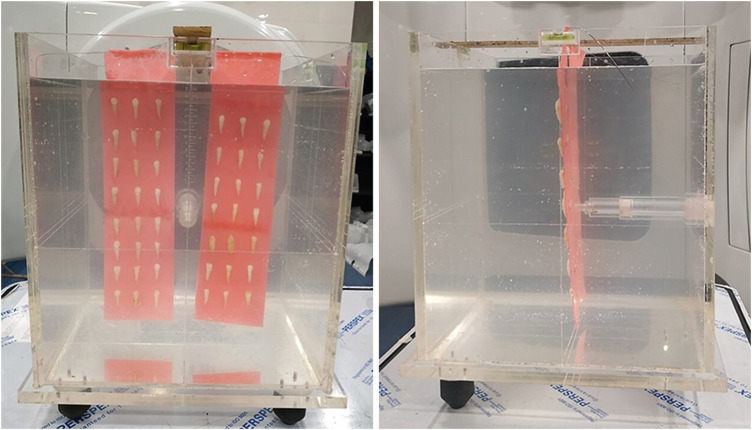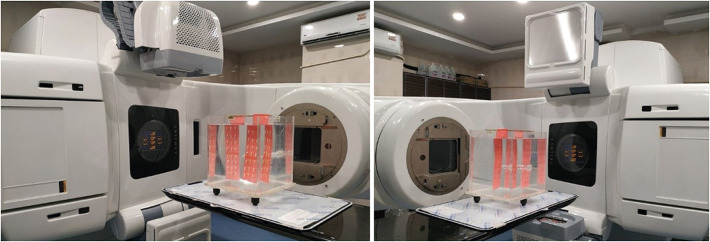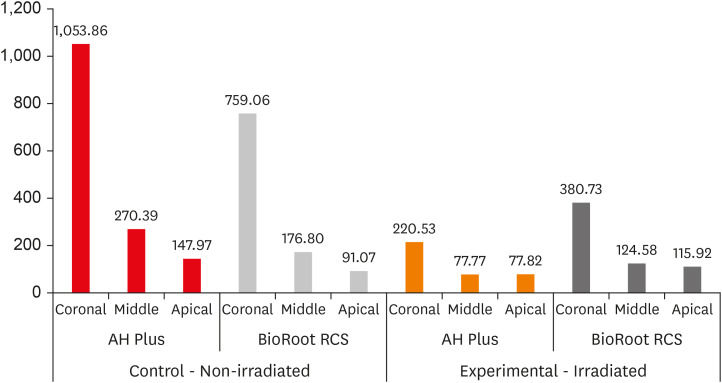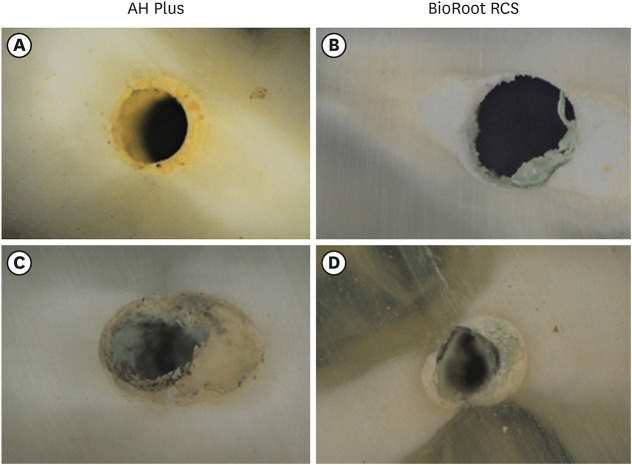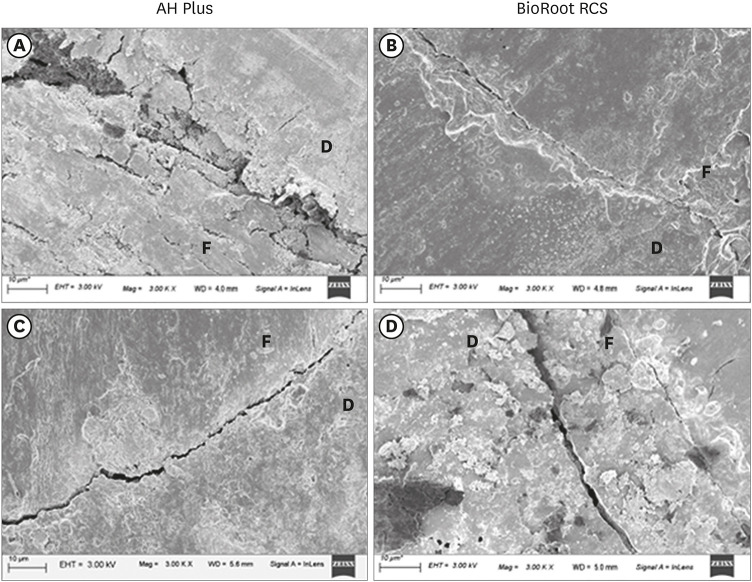Restor Dent Endod.
2021 May;46(2):e22. 10.5395/rde.2021.46.e22.
Effects of radiation therapy on the dislocation resistance of root canal sealers applied to dentin and the sealer-dentin interface: a pilot study
- Affiliations
-
- 1Department of Conservative Dentistry and Endodontics, Regional Dental College, Guwahati, AS, India
- 2Medical Physics Division, Department of Radiation Oncology, Dr. B Borooah Cancer Institute, Guwahati, AS, India
- KMID: 2548066
- DOI: http://doi.org/10.5395/rde.2021.46.e22
Abstract
Objectives
This study evaluated and compared the effects of radiation therapy on the dislocation resistance of AH Plus and BioRoot RCS applied to dentin and the sealer-dentin interface.
Materials and Methods
Thirty single-rooted teeth were randomly assigned to 2 groups (n = 15 each): AH Plus (Dentsply DeTrey) and BioRoot RCS (Septodont). Each group was subdivided into control and experimental groups. The experimental group was subjected to a total radiation dose of 60 Gy. The root canals of all samples were cleaned, shaped, and obturated using the single-cone technique. Dentin slices (1 mm) were sectioned from each root third for the push-out test and scanning electron microscopy (SEM) was done to examine the sealer-dentin interface. The failure mode was determined using stereomicroscopy. Bond strength data were analyzed by the independent t-test, 1-way analysis of variance, and the Tukey post hoc test (α = 0.05).
Results
Significantly lower bond strength was observed in irradiated teeth than nonirradiated teeth in the AH Plus group (p < 0.05). The BioRoot RCS group showed no significant reduction in bond strength after irradiation (p > 0.05) and showed a higher post-irradiation bond strength (209.92 ± 172.26 MPa) than the AH Plus group. SEM revealed slightly larger gap-containing regions in irradiated specimens from both groups.
Conclusions
The dislocation resistance of BioRoot RCS was not significantly changed by irradiation and was higher than that of AH Plus. BioRoot RCS may be the sealer of choice for root canal treatment in patients undergoing radiation therapy.
Keyword
Figure
Reference
-
1. Reed R, Xu C, Liu Y, Gorski JP, Wang Y, Walker MP. Radiotherapy effect on nano-mechanical properties and chemical composition of enamel and dentine. Arch Oral Biol. 2015; 60:690–697. PMID: 25766468.
Article2. Gonçalves LM, Palma-Dibb RG, Paula-Silva FW, Oliveira HF, Nelson-Filho P, Silva LA, Queiroz AM. Radiation therapy alters microhardness and microstructure of enamel and dentin of permanent human teeth. J Dent. 2014; 42:986–992. PMID: 24887361.
Article3. de Siqueira Mellara T, Palma-Dibb RG, de Oliveira HF, Garcia Paula-Silva FW, Nelson-Filho P, da Silva RA, da Silva LA, de Queiroz AM. The effect of radiation therapy on the mechanical and morphological properties of the enamel and dentin of deciduous teeth--an in vitro study. Radiat Oncol. 2014; 9:30. PMID: 24450404.4. Soares CJ, Castro CG, Neiva NA, Soares PV, Santos-Filho PC, Naves LZ, Pereira PN. Effect of gamma irradiation on ultimate tensile strength of enamel and dentin. J Dent Res. 2010; 89:159–164. PMID: 20042736.
Article5. Springer IN, Niehoff P, Warnke PH, Böcek G, Kovács G, Suhr M, Wiltfang J, Açil Y. Radiation caries--radiogenic destruction of dental collagen. Oral Oncol. 2005; 41:723–728. PMID: 15979926.
Article6. Muliyar S, Shameem KA, Thankachan RP, Francis PG, Jayapalan CS, Hafiz KA. Microleakage in endodontics. J Int Oral Health. 2014; 6:99–104.7. Dow PR, Ingle JI. Isotope determination of root canal failure. Oral Surg Oral Med Oral Pathol. 1955; 8:1100–1104. PMID: 13266341.
Article8. Donnermeyer D, Dornseifer P, Schäfer E, Dammaschke T. The push-out bond strength of calcium silicate-based endodontic sealers. Head Face Med. 2018; 14:13. PMID: 30126425.
Article9. Balguerie E, van der Sluis L, Vallaeys K, Gurgel-Georgelin M, Diemer F. Sealer penetration and adaptation in the dentinal tubules: a scanning electron microscopic study. J Endod. 2011; 37:1576–1579. PMID: 22000467.
Article10. Tyagi S, Mishra P, Tyagi P. Evolution of root canal sealers: an insight story. Eur J Gen Dent. 2013; 2:199.
Article11. Siboni F, Taddei P, Zamparini F, Prati C, Gandolfi MG. Properties of BioRoot RCS, a tricalcium silicate endodontic sealer modified with povidone and polycarboxylate. Int Endod J. 2017; 50(Supplement 2):e120–e136. PMID: 28881478.
Article12. Gurgel-Filho ED, Leite FM, de Lima JB, Montenegro JPC, Saavedra F, Silva EJNL. Comparative evaluation of push-out bond strength of a MTA-based root canal sealer. Braz J Oral Sci. 2014; 13:114–117.
Article13. Ørstavik D, Eriksen HM, Beyer-Olsen EM. Adhesive properties and leakage of root canal sealers in vitro . Int Endod J. 1983; 16:59–63. PMID: 6345404.14. Martins CV, Leoni GB, Oliveira HF, Arid J, Queiroz AM, Silva LA, Sousa-Neto MD. Influence of therapeutic cancer radiation on the bond strength of an epoxy- or an MTA-based sealer to root dentine. Int Endod J. 2016; 49:1065–1072. PMID: 26426161.
Article15. Pane ES, Palamara JE, Messer HH. Critical evaluation of the push-out test for root canal filling materials. J Endod. 2013; 39:669–673. PMID: 23611388.
Article16. Jawad H, Hodson NA, Nixon PJ. A review of dental treatment of head and neck cancer patients, before, during and after radiotherapy: part 1. Br Dent J. 2015; 218:65–68. PMID: 25613260.
Article17. Vissink A, Jansma J, Spijkervet FK, Burlage FR, Coppes RP. Oral sequelae of head and neck radiotherapy. Crit Rev Oral Biol Med. 2003; 14:199–212. PMID: 12799323.18. Yamin PA, Pereira RD, Lopes FC, Queiroz AM, Oliveira HF, Saquy PC, Sousa-Neto MD. Longevity of bond strength of resin cements to root dentine after radiation therapy. Int Endod J. 2018; 51:1301–1312. PMID: 29729026.
Article19. Bodrumlu E, Avsar A, Meydan AD, Tuloglu N. Can radiotherapy affect the apical sealing ability of resin-based root canal sealers? J Am Dent Assoc. 2009; 140:326–330. PMID: 19255177.
Article20. Paiola FG, Lopes FC, Mazzi-Chaves JF, Pereira RD, Oliveira HF, Queiroz AM, Sousa-Neto MD. How to improve root canal filling in teeth subjected to radiation therapy for cancer. Braz Oral Res. 2018; 32:e121. PMID: 30517430.
Article21. World Health Organization. Medical devices: managing the mismatch: an outcome of the priority medical devices project. Geneva: World Health Organization;2010.22. Sudsangiam S, van Noort R. Do dentin bond strength tests serve a useful purpose? J Adhes Dent. 1999; 1:57–67. PMID: 11725686.23. Moinzadeh AT, Jongsma LA, Wesselink PR. Considerations about the use of the “push-out” test in Endodontic research. Int Endod J. 2015; 48:498–500. PMID: 25418798.
Article24. Neelakantan P, Ahmed HMA, Wong MCM, Matinlinna JP, Cheung GSP. Effect of root canal irrigation protocols on the dislocation resistance of mineral trioxide aggregate-based materials: a systematic review of laboratory studies. Int Endod J. 2018; 51:847–861. PMID: 29377170.
Article25. Nagas E, Uyanik O, Durmaz V, Cehreli ZC. Effect of plunger diameter on the push-out bond values of different root filling materials. Int Endod J. 2011; 44:950–955. PMID: 21732954.
Article26. Lee KW, Williams MC, Camps JJ, Pashley DH. Adhesion of endodontic sealers to dentin and gutta-percha. J Endod. 2002; 28:684–688. PMID: 12398164.
Article27. Neelakantan P, Subbarao C, Subbarao CV, De-Deus G, Zehnder M. The impact of root dentine conditioning on sealing ability and push-out bond strength of an epoxy resin root canal sealer. Int Endod J. 2011; 44:491–498. PMID: 21255047.
Article28. Mjör IA. Human coronal dentine: structure and reactions. Oral Surg Oral Med Oral Pathol. 1972; 33:810–823. PMID: 4552855.
Article29. McGuire JD, Mousa AA, Zhang BJ, Todoki LS, Huffman NT, Chandrababu KB, Moradian-Oldak J, Keightley A, Wang Y, Walker MP, Gorski JP. Extracts of irradiated mature human tooth crowns contain MMP-20 protein and activity. J Dent. 2014; 42:626–635. PMID: 24607847.
Article30. Ginebra MP, Fernández E, De Maeyer EA, Verbeeck RM, Boltong MG, Ginebra J, Driessens FC, Planell JA. Setting reaction and hardening of an apatitic calcium phosphate cement. J Dent Res. 1997; 76:905–912. PMID: 9126187.
Article31. Sarkar NK, Caicedo R, Ritwik P, Moiseyeva R, Kawashima I. Physicochemical basis of the biologic properties of mineral trioxide aggregate. J Endod. 2005; 31:97–100. PMID: 15671817.
Article32. Reyes-Carmona JF, Felippe MS, Felippe WT. Biomineralization ability and interaction of mineral trioxide aggregate and white portland cement with dentin in a phosphate-containing fluid. J Endod. 2009; 35:731–736. PMID: 19410094.
Article33. Reyes-Carmona JF, Felippe MS, Felippe WT. The biomineralization ability of mineral trioxide aggregate and Portland cement on dentin enhances the push-out strength. J Endod. 2010; 36:286–291. PMID: 20113792.
Article34. Han L, Okiji T. Uptake of calcium and silicon released from calcium silicate-based endodontic materials into root canal dentine. Int Endod J. 2011; 44:1081–1087. PMID: 21777256.
Article35. Zach GA. X-ray diffraction and calcium-phosphorous analysis of irradiated human teeth. J Dent Res. 1976; 55:907–909. PMID: 1067306.
Article
- Full Text Links
- Actions
-
Cited
- CITED
-
- Close
- Share
- Similar articles
-
- Dentin moisture conditions strongly influence its interactions with bioactive root canal sealers
- The influence of AH-26 and zinc oxide-eugenol root canal sealer on the shear bond strength of composite resin to dentin
- A comparative study on radiopacity of root canal sealers
- Cytotoxicity of resin-based root canal sealer, adseal
- Calcium silicate-based root canal sealers: a literature review

